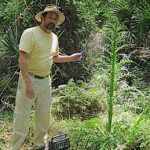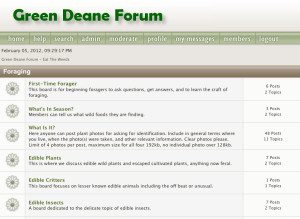
I have not found any ripe cherries so far this season. Photo by Green Deane

Blueberries, are a bit late this year, Photo by Green Deane.
Several observations suggest the seasons are off. April is our target month for several wild fruit ripening such as Black Cherries, blue berries, blackberries, mulberries, Surinam cherries and loquats, The first three have been late and are only beginning to ripen. The amount of rain has also been light so traditional mushrooms seasons have not started. By now we are usually picking blueberries, and plenty of blackberries, and sampling black cherries. Not so this early May. Mulberries and Loquats, have performed well.The Suriname Cherries have been spotty.

Candyroots vary in height. Photo by Green Deane
In the realm of plant populations there is endangered, threatened then rare. But there is a huge distance between rare and common. The yellow bloomer to the leftt — Candyroot — is not on any about-to-disappear list but one doesn’t see them that often. You have to be at the right place — seasonally damp pine scrub — and the right season, April and May in Florida but it can be found later in the year. Candyroot comes in two colors, yellow that can sometimes make it to orange. Native Americans and early Europeans would chew the roots, which have a spearmint-esque flavor, or wintergreen, and to some palates licorice. The tap root is also rather small, so it’s not much of a chew. Kind of like a woodland breath mint. To read more about Candyroot you can click here.

Yellow pond lily, blossom and seed pod. Photo by Green Deane.
Yellow ponds, that’s how I think of it, or in some places, yellow rivers. That’s because the American Lotus is in blossom. The first time I saw a small lake of these blossoms was when an old dry lake was deepened for a housing development. The next spring suddenly what was for decades a dry lake was full of American Lotus blossoms. This is because the seeds can stay viable some 400 years, or so the experts report. Talk about a survival food! There are multiple edible parts on the American Lotus but I prefer the seeds. I also think when collecting by hand the seeds proved to be the most calories for the amount of work. The roots are edible but digging them up can be a messy, laborious job. Locally American Lotus are easy to find now: Just look for a lake with large yellow blossoms on long stems. Further north and west they are a favorite sight on rivers such as the Mississippi. To read more about the American Lotus go here.
Foraging classes this weekend:

Foraging classes are held rain, shine, hot or cold. Photo by Nermina Krenata
Saturday, May 4th, Eagle Park Lake, 1800 Keene Road, Largo, FL 33771. Meet at the pavilion near the dog park. 9 to noon.
Sunday, May 5th, Boulware Springs Park, 3420 SE 15th St., Gainesville, FL 32641. Meet at the picnic tables next to the pump house. 9 a.m. to noon.
For more information on these classes, to prepay or sign up go here

Eggs come in many colors and sizes. Photo by Green Deane
Though demonized, forgiven, and demonized again eggs have always been a large part of my diet. I eat ancestrally and eggs were definitely on the menu. The local farm store has sales that sometimes includes duck eggs which I grew up eating. We also had chickens (and pet squirrels, rabbits, dogs, cats and horses… my mother collected horses and I had to take care of them so much that in 1969 I volunteered for the Army to get away from horses and haying.) Three local turkeys provide their large pointed eggs and I find ducks eggs often in parks with a quacking population. A few years ago I noticed that most “survivalist” and or “prepper” sites and articles just did not mention eggs. That prompted me to write a large article on eggs, birds to fish. You can read it here.

Green Deane Forum
Tired of Facebook and want to identify a plant? The Green Dean Forum is up and running again. Have you come to dislike Facebook, then join us on the forum. Perhaps you’re looking for a foraging reference? You might have a UFO, an Unidentified Flowering Object, you want identified. On the Green Deane Forum we — including Green Deane and others from around the world — chat about foraging all year. And it’s not just about warm-weather plants or just North American flora. Many nations share common weeds so there’s a lot to talk. There’s also more than weeds. The reference section has information for foraging around the world. There are also articles on food preservation, and forgotten skills from making bows to fermenting food.

You get the USB, not the key.
172-video USB would be a good end of spring present and is now $99. My nine-DVD set of 135 videos has been phased out. The USB videos are the same videos I have on You Tube. Some people like to have their own copy. Most of the 172 USB videos have to be copied to your computer to play. If you want to order the USB go to the DVD/USB order button on the top right of this page. That will take you to an order form.

Finally, a physical copy of the book.
Now in its second printing is EatTheWeeds, the book. It has 274 plants, 367 pages, index, nutrition charts and color photos. It’s available in many locations including Amazon. Most of the entries include a nutritional profile. It can also be ordered through AdventureKeen Publishing.
This is weekly newsletter #599. If you want to subscribe to this free newsletter you can find the sign-up form in the menu at the top of the page.
To donate to the Green Deane Newsletter click here.


My favorite eggs are goose eggs. Better than duck. Just had my first one about a month ago.